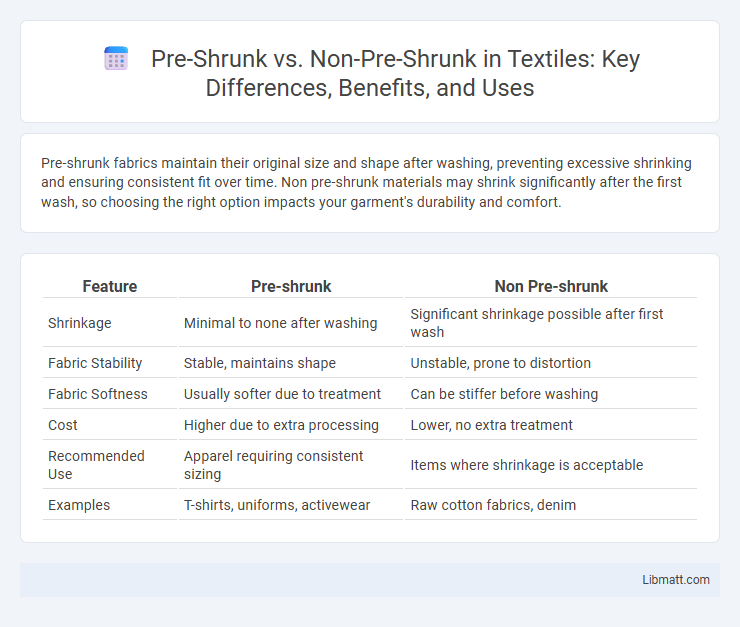Pre-shrunk fabrics maintain their original size and shape after washing, preventing excessive shrinking and ensuring consistent fit over time. Non pre-shrunk materials may shrink significantly after the first wash, so choosing the right option impacts your garment's durability and comfort.
Table of Comparison
| Feature | Pre-shrunk | Non Pre-shrunk |
|---|---|---|
| Shrinkage | Minimal to none after washing | Significant shrinkage possible after first wash |
| Fabric Stability | Stable, maintains shape | Unstable, prone to distortion |
| Fabric Softness | Usually softer due to treatment | Can be stiffer before washing |
| Cost | Higher due to extra processing | Lower, no extra treatment |
| Recommended Use | Apparel requiring consistent sizing | Items where shrinkage is acceptable |
| Examples | T-shirts, uniforms, activewear | Raw cotton fabrics, denim |
Understanding Pre-shrunk and Non Pre-shrunk Fabrics
Pre-shrunk fabrics undergo a controlled washing process to minimize shrinkage after purchase, ensuring consistent fit and size stability. Non pre-shrunk fabrics retain natural fibers and have not been treated to prevent shrinkage, which means they may shrink significantly after washing. Understanding the distinction helps in selecting garments with predictable sizing and maintaining fabric integrity.
Key Differences Between Pre-shrunk and Non Pre-shrunk Materials
Pre-shrunk materials undergo a treatment process to minimize shrinkage after washing, ensuring a more consistent fit and shape, while non pre-shrunk fabrics retain their natural tendency to shrink when exposed to moisture and heat. Pre-shrunk garments are often preferred for their durability and predictable sizing, whereas non pre-shrunk options may offer a softer feel but require extra care to prevent unexpected changes. Your choice depends on whether you prioritize ease of maintenance or a more traditional, natural fabric texture.
How Pre-shrinking Works: The Process Explained
Pre-shrinking involves treating fabric with moisture and heat to reduce shrinkage during future washes, typically using steaming or washing followed by controlled drying. This process stabilizes the fibers by relaxing tension introduced during weaving or knitting, ensuring garments maintain their original size and shape after laundering. As a result, pre-shrunk fabrics offer enhanced durability and consistent fit compared to non pre-shrunk materials, which may shrink unpredictably.
Advantages of Pre-shrunk Clothing
Pre-shrunk clothing offers significant advantages such as better fit retention and reduced shrinkage after washing, ensuring your garments maintain their original size and shape over time. This quality minimizes the risk of unexpected changes in length or width, providing consistent comfort and appearance. Choosing pre-shrunk fabrics can save you time and effort in garment care, enhancing the longevity and reliability of your wardrobe.
Drawbacks of Non Pre-shrunk Garments
Non pre-shrunk garments tend to shrink significantly after the first wash, leading to unpredictable sizing and fit issues. This shrinkage can distort garment dimensions, causing discomfort and reducing the lifespan of the clothing. Consumers often face frustration and additional costs from the need to replace or alter non pre-shrunk items.
Impact on Fit and Sizing After Washing
Pre-shrunk fabrics maintain their original size and shape after washing, ensuring consistent fit and sizing without significant shrinkage. Non pre-shrunk garments are more likely to shrink during the first few washes, which can result in smaller dimensions and tighter fit than expected. Understanding this difference helps you choose clothing that retains the desired fit after laundering, reducing the risk of size-related issues.
Durability: Pre-shrunk vs Non Pre-shrunk Fabrics
Pre-shrunk fabrics undergo a controlled shrinking process before being cut and sewn, resulting in more consistent sizing and enhanced durability as the fibers are stabilized to resist future shrinkage and wear. Non pre-shrunk fabrics retain natural tensions within the fibers, which can cause unpredictable shrinking and potential weakening of the fabric structure after washing, reducing overall durability. Consequently, pre-shrunk textiles often maintain their shape, strength, and appearance longer than non pre-shrunk counterparts under similar usage conditions.
Common Uses for Pre-shrunk Textiles
Pre-shrunk textiles are commonly used in apparel such as t-shirts, jeans, and sportswear to maintain size and fit after washing, enhancing garment durability and customer satisfaction. These fabrics are favored by manufacturers and retailers for producing consistent, shrink-resistant products that require minimal care. Pre-shrunk textiles also find extensive applications in uniforms and children's clothing, where reliable sizing is crucial.
Care Instructions for Both Fabric Types
Pre-shrunk fabric requires minimal care adjustments as it retains its original size after washing, allowing you to follow standard machine-wash instructions without worrying about significant shrinkage. Non pre-shrunk fabric needs careful handling to avoid size reduction, best washed in cold water and air-dried or tumble-dried on low heat to maintain shape. Understanding these care instructions ensures your garments stay true to size and last longer.
Choosing the Right Option: Which Fabric is Best for You?
Pre-shrunk fabrics undergo a controlled shrinking process to minimize size changes after washing, making them ideal for maintaining consistent fit and avoiding surprises in garment size. Non pre-shrunk fabrics offer a more natural texture and feel but require you to account for potential shrinkage during your washing and drying routine. Choosing the right option depends on your priorities for garment care and longevity, with pre-shrunk fabric providing convenience and non pre-shrunk fabric offering authenticity and potential customization through natural shrinkage.
Pre-shrunk vs Non Pre-shrunk Infographic

 libmatt.com
libmatt.com